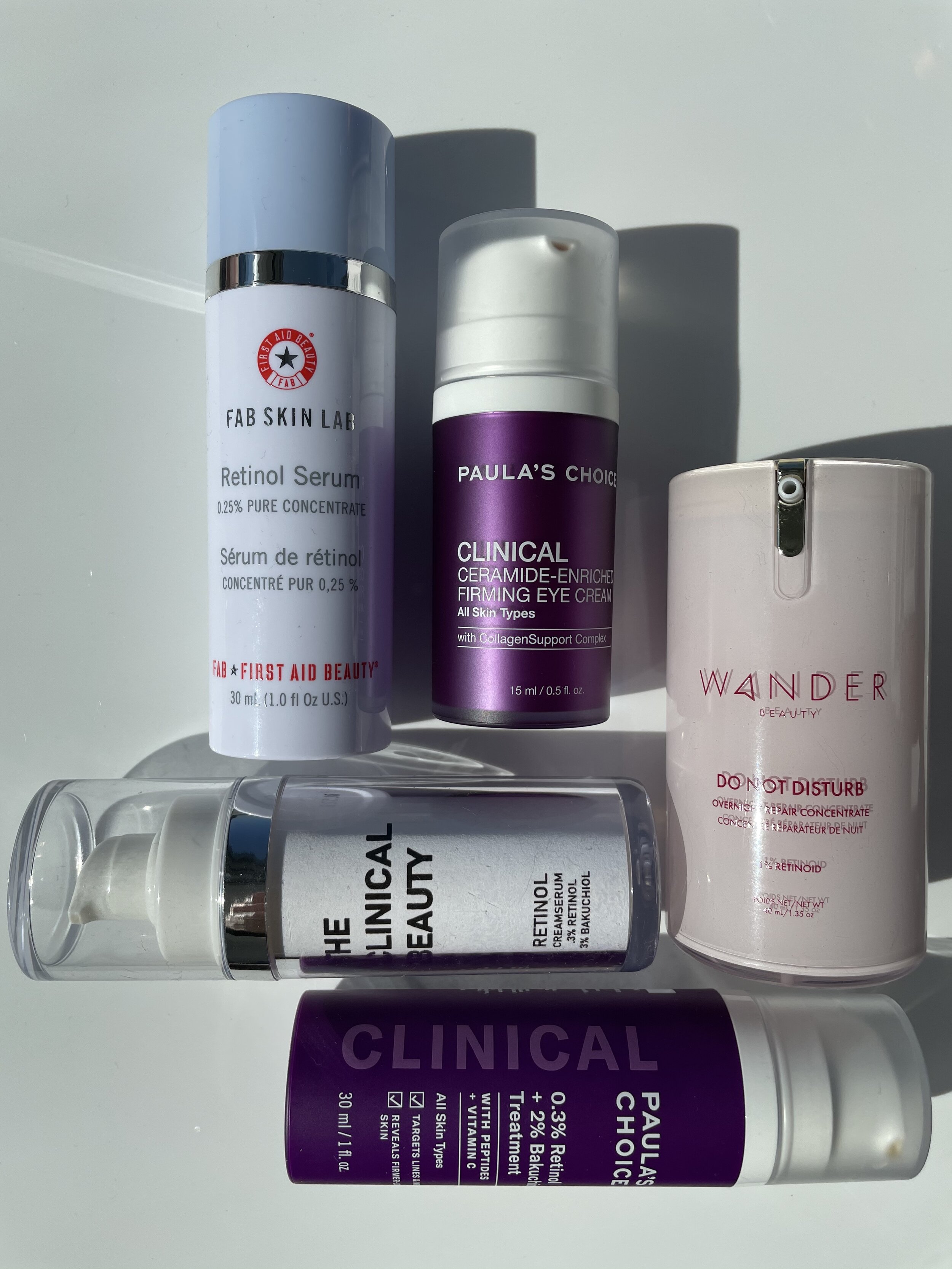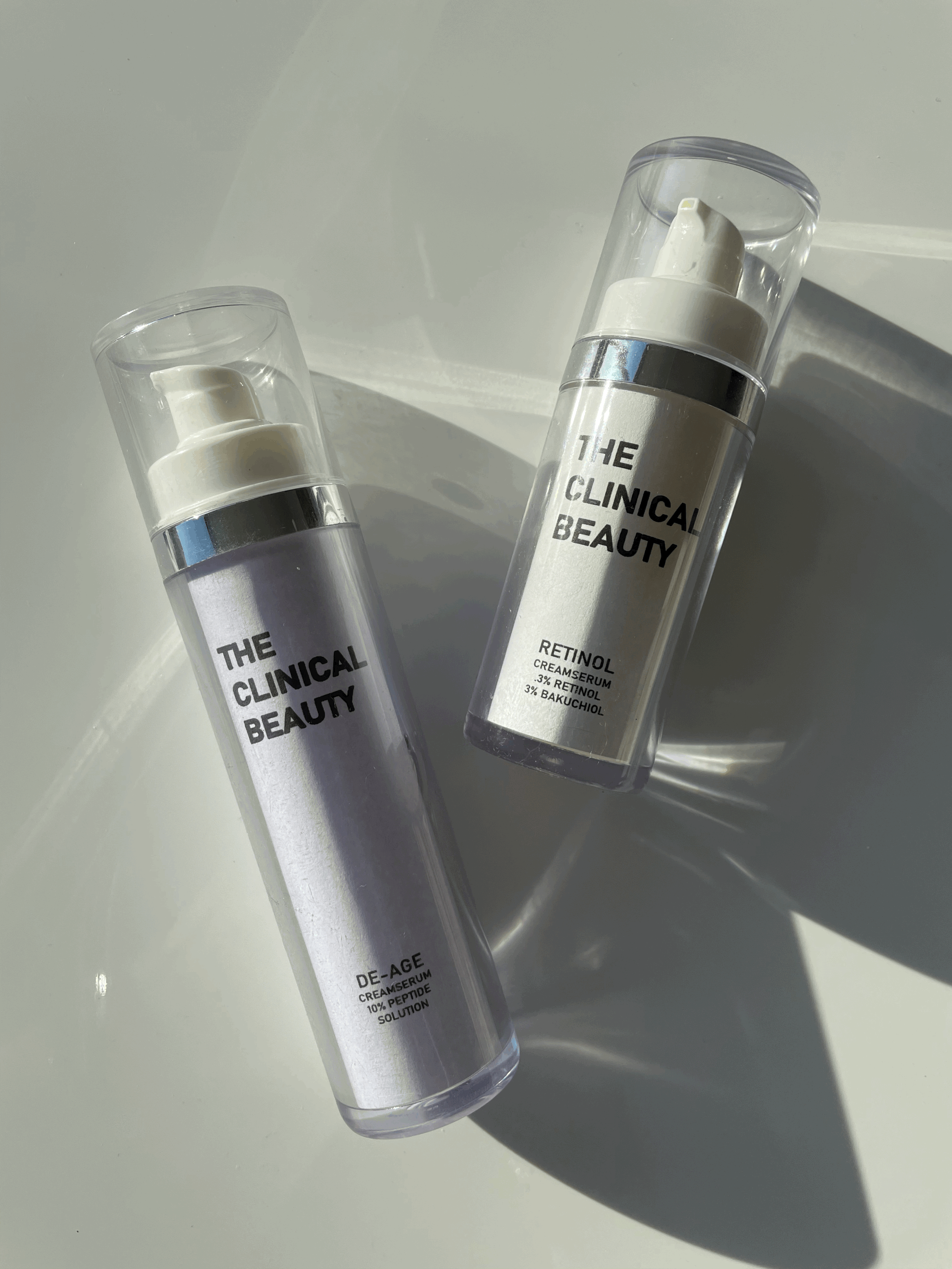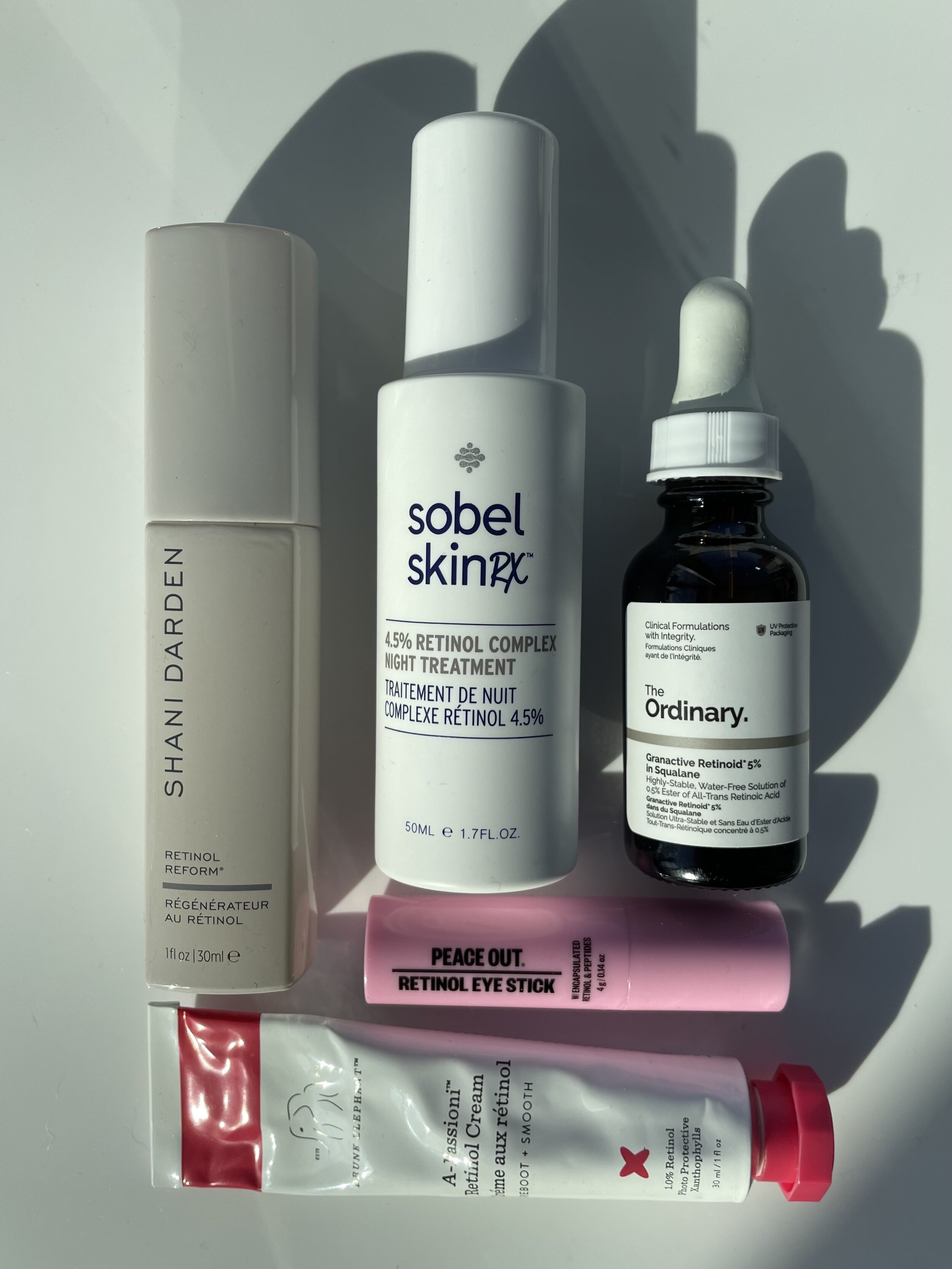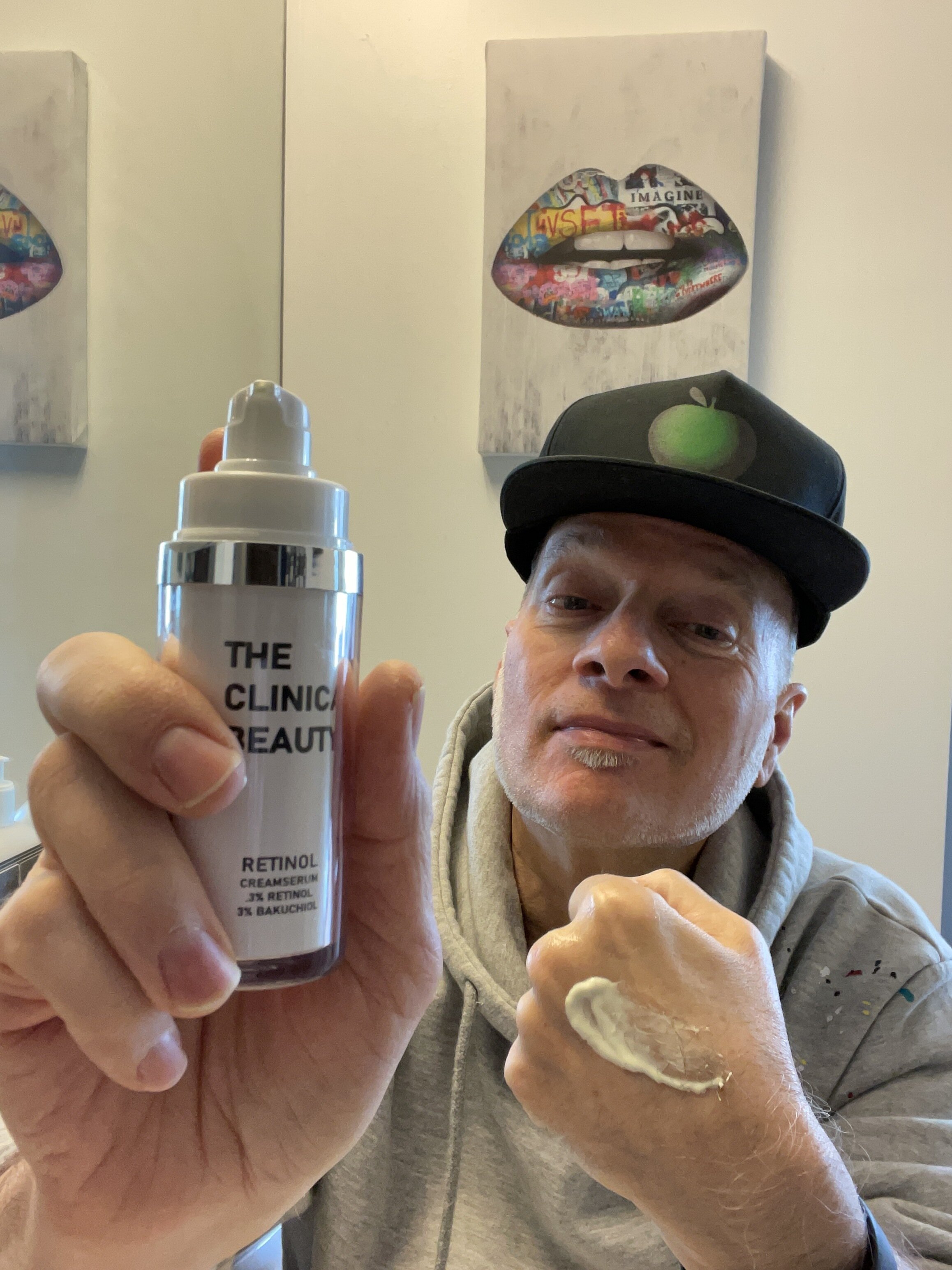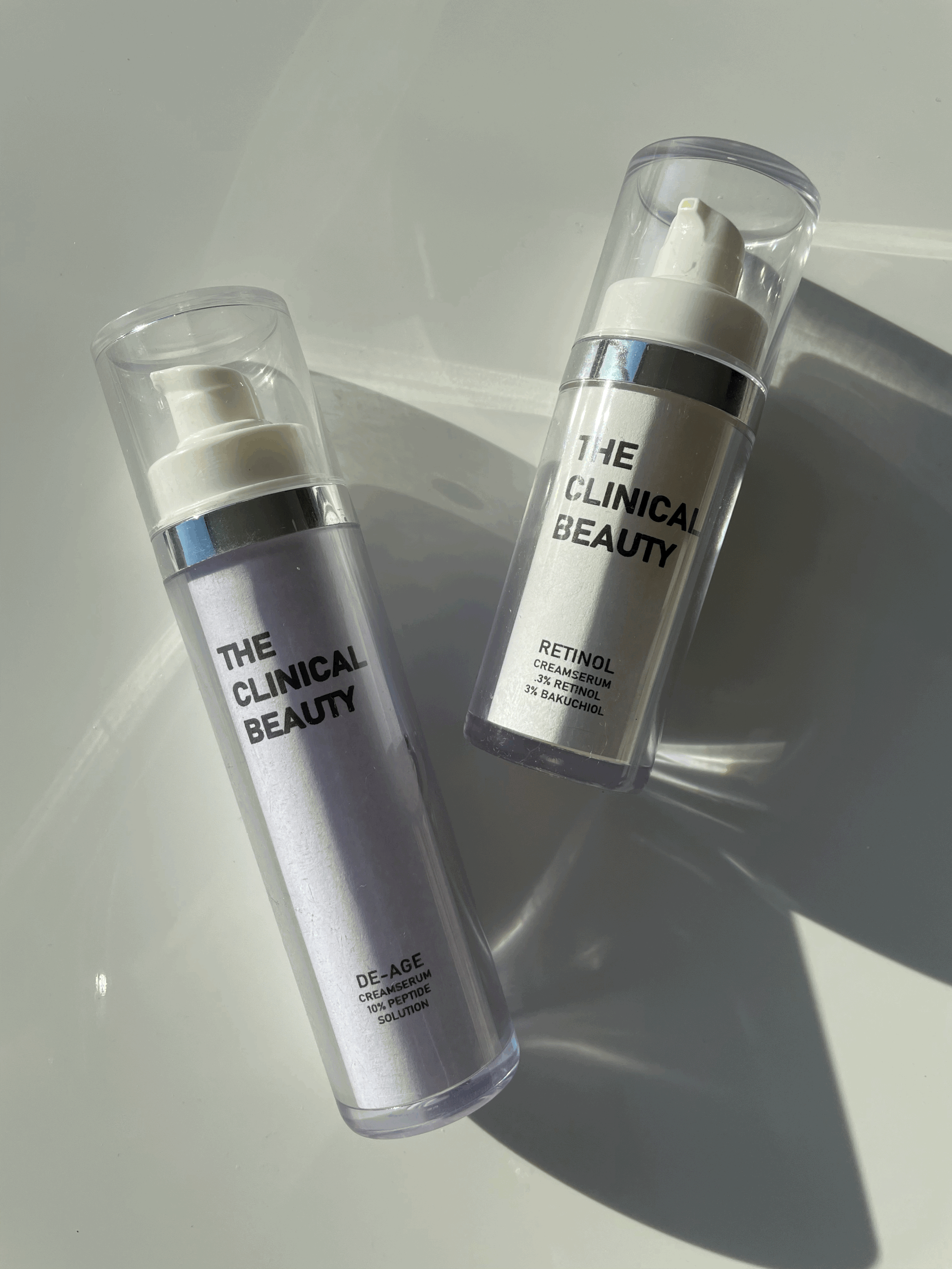PRODUCT REVIEW: THE CLINICAL BEAUTY | 0.3% RETINOL AND 3% BAKUCHIOL CREAMSERUM - BEST RETINOL CREAM, BEST ANTI-AGING CREAM WITH RETINOL
The Clinical Beauty | 0.3% Retinol And 3% Bakuchiol Creamserum
This review was originally part of my blog article titled, Retinol, Retinoids, Retinoic Acid Part One: Best Retinol Serums, Best Retinol Creams from Paula's Choice, Wander Beauty and First Aid Beauty. You can still catch the full piece here.
—
I haven’t always been a fan of Retinol and Do Not Disturb has literally transformed how I feel about Retinol treatments. (More on the Wander Beauty Do Not Disturb Overnight Repair Concentrate below.)
My first real experience with Retinol was the Paula’s Choice Clinical 1% Retinol Treatment. To me, that’s the OG of Retinol products. Much like the Paula’s Choice 10% Niacinamide Booster is the OG Niacinamide serum — and perhaps the best anti-aging serum ever. (Psst…I’ve reviewed it on the blog here.)
SAVE 20% ON ALL SKINCARE FROM THE CLINICAL BEAUTY AND OTHER CLEAN BEAUTY CO BRANDS!
ENTER CODE SKINCARMA20OFF.AT CHECKOUT.
Paula’s 1% Retinol Treatment made Retinol an indispensable part of my regular skincare routine. My first experience with it was like playing with fire. Retinol is like that. You have to proceed with caution. Many people build up a tolerance for it that allows them to use it daily.
Not me. I can use a Retinol treatment once, sometimes twice, a week. You have to find your own balance. It took me a long time to accept that I wasn’t going to get up to daily use — and didn’t need to.
What Is Retinol and What Does Retinol Do for the Skin?
It’s commonly accepted that Retinol and retinoids, more specifically, are the gold standard in anti-aging. Like Vitamin C and Niacinamide (Vitamin B3), the Vitamin A derivative has multiple pro-skin health, anti-aging benefits. Among them are the smoothing of lines and wrinkles, potent antioxidant defense and visible skin firming. As with Niacinamide, topical retinoids — as all derivatives of Vitamin A are referred to — can even minimize the appearance of pores and defend skin against aging environmental damage.
There’s a superb piece on retinoids by the experts on the Paula’s Choice Research Team titled, The Complete Guide To Retinol: The Anti-Aging (And Anti-Acne) Hero — which you can catch here. Here is what I found most salient:
Retinol is classified as a Cell-Communicating Ingredient, which means that it can tell a skin cell how to behave. Retinol ‘tells’ developing skin cell in the lower layers of the skin – called the dermis, to develop normally, instead of a sun-damaged or genetically malformed skin cell. This is how, over time, Retinol can address multiple skin concerns.
Another way Retinol works is also by telling the older cells in the upper layer of skin to die quicker which in turn allows the newer, healthier skin to surface faster. This quicker skin cell turnover rate, paired with cell communicating abilities is what makes Retinol such a superstar!
There are many derivatives and strengths of retinoids available in both over-the-counter (OTC) and prescription products today. The term “Retinol” is the name of the purest form of Vitamin A, and used most often to refer to the non-prescription version of Retinoids.
However, Retinol itself is not active. It has to go through a conversion process in the skin to get to the active form which is then usable by the skin.
Retinyl Palmitate –> Retinol — > Retinaldehyde –> All-Trans-Retinoic Acid (Tretinoin)
WATCH MY VIDEO REVIEW
NIACINAMIDE IS THE GAME CHANGER YOU NEED - THE BEST NIACINAMIDE SERUMS FROM PAULA'S CHOICE & MORE!
ON MY YOUTUBE CHANNEL HERE
There are many forms of retinoids used in skincare today and it can get confusing. Brands and their formulators have multiple format options in seemingly infinite concentrations, depending on the formulation and the product’s claims positioning. Here is a breakdown of the most common forms with a brief description.
Retinyl Palmitate
This form of Vitamin A is created by combining Retinol, or pure Vitamin A, and palmitic acid – a saturated fatty acid derived from palm oil. Retinyl Palmitate is actually naturally occurring in the skin. Because of the lengthy conversion process required within the skin, it’s the least effective of the retinoids. As the weakest form, it’s also generally the most well tolerated.
Retinyl Palmitate gets a bad rap and is on the clean beauty ingredient hit lists of both Sephora and Credo, meaning a formula that contains it cannot be classified as “clean”. According to the experts on the Paula’s Choice Research Team, the claims that it’s unsafe are “based on a study from nearly 20 years ago that has never been reproduced or tested under real-life conditions such as how people use sunscreens that contain this ingredient.”
Retinol
The term “retinol” has become the catch-all for all forms of retinoids in skincare marketing. To be exact, Retinol is the name for the entire vitamin A molecule and the purest form of the antioxidant vitamin. While its anti-aging benefits are proven, it also has legitimate downsides; notably, Retinol can cause extreme sensitization, irritation, redness, dryness and unsightly flaking of the skin.
What causes Retinol irritation? Well, in order to achieve the unparalleled results of Retinol, the molecule must go through a lengthy molecular transformation in the skin as it converts to retinoic acid. It is this conversion process that causes the significant downsides associated with Retinol.
Ironically, while it’s known for causing skin sensitivity, Retinol is also quite sensitive itself. It needs to be packaged in an opaque, air-tight pump as it easily degrades in the presence of light and air. Just like its BFF Vitamin C!
Retinaldehyde (Retinal)
Retinal is even more potent and effective on the retinoid scale than Retinol itself. Interestingly, “Retinaldehyde has promise in being an anti-acne treatment, without the same harsh side effects of its prescription cousins.”
Because it is perhaps the most expensive of the retinoid class, it’s seldom used in topical skincare products — and is reserved for the savvy marketers who want their Retinol treatment to sound unique and to boast the highest efficacy without a prescription. The default is most often to formulate with the less expensive Retinol. Because of its higher potency, Retinaldehyde is used in lower concentrations, which can give the impression that the formula is weaker from a marketing perspective.
PRODUCT REVIEW: PAULA’S CHOICE 0.3% RETINOL + 2% BAKUCHIOL TREATMENT - BEST RETINOL FACE CREAM
Retinyl Retinoate
This synthetic form of Vitamin A is part of a new generation of retinoids. Because of its slower conversion in the skin into Retinoic Acid, studies have shown it to be less problematic for skin than Retinol and pure form of topical Retinoic Acid — more commonly known as Tretinoin or Retin-A.
Because of the serious downsides of using Retinol, Retinyl Retinoate may become increasingly popular in the years ahead.
Hydroxypinacolone Retinoate (HPR) or Granactive Retinoid
Marketed as Granactive Retinoid, Hydroxypinacolone Retinoate (HPR) is the newest and most promising member of the class of anti-aging retinoids. HPR is an ester of retinoic acid with benefits on par with prescription-strength retinoic acid, commonly known as Tretinoin or Retin-A. The greatest benefit is that HPR is more readily tolerated by the skin, with none of the side effects of Retinol or retinoic acid — including irritation, sensitivity, dryness and flakiness.
How is it possible to have the upside without the downside? In order for the skin to benefit from Retinol, the Vitamin A molecule goes through a transformation process as it converts to retinoic acid in the skin. It is this conversion that leads to the irritation common to Retinol. Hydroxypinacolone retinoate does not require a lengthy conversion in order to achieve the sought-after anti-aging benefits of Retinol, making it far more tolerable.
RETINOL, RETINOIDS, RETINOIC ACID PART TWO: BEST RETINOL CREAMS FROM DRUNK ELEPHANT, SHANI DARDEN & MORE
Tretinoin / Retin-A
With Retinyl Palmitate at the low end of the retinoid scale, Tretinoin (or Retin-A) is at the exact opposite end — the strongest of the retinoids known as retinoic acid, the generic name for synthetic Vitamin A. Tretinoin is only available by prescription in most countries — except notably, Mexico, where its access is quite pervasive. Even I have been caught up in grabbing tubes of Retin-A at the airport before my flights home.
While Tretinoin is commonly used to treat signs of aging including fine lines, wrinkles and dark spots, the versatile medication is also an effective treatment for acne and sun-damaged skin. According to the Healthline website, “It may sound counterintuitive, but tretinoin works by irritating the skin. Tretinoin is able to speed up the life cycle of skin cells. It makes them divide faster and die faster, so newer, healthier cells can take their place.”
Let’s take a look at one of the best face creams with Retinol from my collection of ten retinoid recommendations…
The Clinical Beauty | 0.3% Retinol and 3% Bakuchiol Creamserum
My first experience of The Clinical Beauty was the brand’s extraordinary Moisture Cream — a 93% natural, 81% organic and 100% skin active moisturizer that I included in my top ten Winter Moisturizers. You can catch my full review of it here.
Claims about the natural and organic content of a skincare product may not be news to you, but the “skin active” call-out may be. It certainly was for me until I understood what made The Clinical Beauty’s products so exceptional.
What Is Bakuchiol?
For insights on what Bakuchiol is and how it can be considered a viable alternative to Retinol, I turn again to the experts on the Paula’s Choice Research Team:
A natural antioxidant and anti-aging ingredient found in the seeds and leaves of the plant Psoralea corylifolia. This plant, also known as babchi, is native to and grows throughout India, where it plays a role in Ayurvedic medicine, and is also found in China (where it’s used in Chinese natural medicine) as well as parts of Africa. Ongoing in vitro (Petri dish) and in vivo (on skin) research has shown that bakuchiol seems to have skin-restoring ability when applied twice daily, and that it may also have a brightening effect on skin. Research has also shown this plant ingredient has soothing and anti-wrinkle properties as well as helping to visibly improve skin color and tone.
Bakuchiol is often touted as an alternative to retinol minus the sensitizing effects some people experience from retinol. The association between bakuchiol and retinol is because many of its benefits seem to mimic what retinol does; however, it’s important to distinguish that bakuchiol is not identical to retinol. It’s not an equivalent replacement any more than a blueberry is the nutritional equivalent of an apple.
Science has revealed that bakuchiol interacts with many of the same areas in skin as retinol, sometimes by taking the same pathway, other times by going a different route but still leading to the same results, such as diminished wrinkles, improved elasticity, and smoother skin. In either case, we’re confident that bakuchiol is a promising, beneficial ingredients whose actions can complement and enhance what retinol does for skin.
Research has confirmed that bakuchiol works best in concentrations between 0.5-2%. Amounts lower than that have not been shown to provide retinol-like benefits.
BAKUCHIOL RETINOL ALTERNATIVE ANTI-AGING SERUMS FROM THE INKEY LIST, HERBIVORE & MORE!
As I said in my earlier review of the brand’s rather blandly named Moisture Cream, you can really feel the difference in your skin: “It feels like a skin reboot.”
What The Clinical Beauty means when they refer to their products as “100% skin active” is that there’s nothing in the formula — not a single ingredient — that doesn’t have a benefit for the skin.
That includes useless water, which literally has zero benefit for the skin beyond a temporary humectant effect. Once the water evaporates from your skin into the air around you, the benefit of it ends. Water in skincare also wastes precious water resources. It’s simply used as a filler and a way to cheapen the cost of goods of a product.
But water isn’t the only useless ingredient in a skincare product. Ingredients like stabilizers, preservatives, texture enhancers, and much of the formula’s base are worthless when it comes to the skin. None of them advance your skin health. They (usually) do no harm, but they do no good either.
SAVE 20% ON ALL SKINCARE FROM THE CLINICAL BEAUTY AND OTHER CLEAN BEAUTY CO BRANDS!
ENTER CODE SKINCARMA20OFF.AT CHECKOUT.
As with the Moisture Cream, The Clinical Beauty’s 0.3% Retinol and 3% Bakuchiol Creamserum is clean and 100% skin active — free of fillers, texture enhancers, and stabilizers. No nonsense, just goodness. The 99% natural and 86% organic formula is formulated with a bio-lamellar phospholipid base made from pure plant cells — precisely what gives the formula its phenomenal texture.
Like the Paula’s Choice 0.3% Retinol + 2% Bakuchiol Treatment, it combines the two anti-aging superstars Retinol and Bakuchiol. But unlike the Paula’s Choice formula, it feels like heaven on the skin.
In addition to the 3% Bakuchiol Extract and 0.3% Retinol, there’s a 0.3% concentration of Ferulic Acid, a potent antioxidant and Vitamin C stabilizer. Notably, the first ingredient in the INCI is organic fermented Aloe Barbadensis — in place of water. Aloe is a super skin-soothing humectant and the fermented form of the common botanical delivers pro-skin health nourishment to the skin.
The Clinical Beauty’s 0.3% Retinol and 3% Bakuchiol Creamserum is one of the most unique Retinol treatments I’ve come across. It’s a soothing, nourishing anti-aging powerhouse for the skin.
SHOP THE BLOG: For a limited time, save 20% off all skin care from The Clinical Beauty. Enter code SKINCARMA20OFF at checkout. Purchase The Clinical Beauty 0.3% Retinol and 3% Bakuchiol Creamserum for $47.20 here.
SHOP THE BLOG:
The Ingredient List of the Wander Beauty Do Not Disturb Overnight Repair Concentrate:
Water/Aqua/Eau, Glycerin, Caprylic/Capric Triglyceride, Hydrogenated Polyisobutene, 1,2-Hexanediol, Cetearyl Alcohol, Methylpropanediol, Dimethicone, Squalane, Dimethyl Isosorbide, Cetearyl Olivate, Polyacrylate-13, Pentaerythrityl Tetraisostearate, Sorbitan Olivate, Polyisobutene, Tocopheryl Acetate, Allantoin, Hydroxypinacolone Retinoate, Polysorbate 20, Lavandula Hybrida Oil, Lavandula Angustifolia (Lavender) Oil, Adenosine, Disodium Edta, Sodium Hyaluronate, Argania Spinosa Kernel Oil, Camellia Japonica Seed Oil, Camellia Sinensis Seed Oil, Macadamia Integrifolia Seed Oil, Olea Europaea (Olive) Fruit Oil, Simmondsia Chinensis (Jojoba) Seed Oil, Propanediol, Butylene Glycol, Monascus Extract, Sodium Guaiazulene Sulfonate, Croton Lechleri Resin Extract, Carbomer, Sodium Lactate, Palmitoyl Pentapeptide-4
The Ingredient List of the Paula’s Choice 0.3% Retinol + 2% Bakuchiol Treatment:
 cci|aox|amic, Arachidyl Alcohol emo|vc, Glyceryl Polymethacrylate vc, Dimethicone Crosspolymer vc, Behenyl Alcohol emo|vc, Glycerin
cci|aox|amic, Arachidyl Alcohol emo|vc, Glyceryl Polymethacrylate vc, Dimethicone Crosspolymer vc, Behenyl Alcohol emo|vc, Glycerin  sii|h 0 0, PEG-75 Shea Butter Glycerides emu|surf, Glyceryl Stearate emo|emu 0 1-2, C12-15 Alkyl Benzoate emo|amic, Polysorbate 20 emu|surf 0 0, Tetrahexyldecyl Ascorbate
sii|h 0 0, PEG-75 Shea Butter Glycerides emu|surf, Glyceryl Stearate emo|emu 0 1-2, C12-15 Alkyl Benzoate emo|amic, Polysorbate 20 emu|surf 0 0, Tetrahexyldecyl Ascorbate  aox|sb, Retinol
aox|sb, Retinol  cci, Ceramide NG
cci, Ceramide NG  sii, Palmitoyl Tetrapeptide-7
sii, Palmitoyl Tetrapeptide-7  cci, Palmitoyl Hexapeptide-12
cci, Palmitoyl Hexapeptide-12  cci, Sodium Hyaluronate
cci, Sodium Hyaluronate  sii|h 0 0, Dipotassium Glycyrrhizate
sii|h 0 0, Dipotassium Glycyrrhizate  so|h, Glycyrrhiza Glabra (Licorice) Root Extract
so|h, Glycyrrhiza Glabra (Licorice) Root Extract  so|sb, Avena Sativa (Oat) Kernel Extract
so|sb, Avena Sativa (Oat) Kernel Extract  aox|so|emo|abrasive/scrub, Arctium Lappa (Burdock) Root Extract
aox|so|emo|abrasive/scrub, Arctium Lappa (Burdock) Root Extract  aox|so, Salix Alba (Willow) Bark Extract
aox|so, Salix Alba (Willow) Bark Extract  so, Glycine Soja (Soybean) Sterols emo, Lecithin
so, Glycine Soja (Soybean) Sterols emo, Lecithin  emo|emu, Allantoin
emo|emu, Allantoin  so 0 0, Tocopheryl Acetate aox 0 0, Hydrolyzed Soy Protein h, Palmitoyl Tripeptide-1
so 0 0, Tocopheryl Acetate aox 0 0, Hydrolyzed Soy Protein h, Palmitoyl Tripeptide-1  cci, Sodium Hydroxide buff, Tribehenin emo, Caprylyl Glycol h|emo, Dipeptide-2
cci, Sodium Hydroxide buff, Tribehenin emo, Caprylyl Glycol h|emo, Dipeptide-2  cci, Polygonum Cuspidatum Root Extract aox, PEG-10 Phytosterol emu, PEG-8 h|solv, Magnesium Aluminum Silicate vc 0 0, Arachidyl Glucoside emu|surf, Chrysin, Pentylene Glycol solv|h, Sodium Acrylates Copolymer vc, Steareth-20 emu|surf 1 2, Hydroxyethyl Acrylate/Sodium Acryloyldimethyl Taurate Copolymer vc, Cetearyl Alcohol emo|vc|emu|surf 1 2, Coco-Glucoside surf, Hesperidin Methyl Chalcone
cci, Polygonum Cuspidatum Root Extract aox, PEG-10 Phytosterol emu, PEG-8 h|solv, Magnesium Aluminum Silicate vc 0 0, Arachidyl Glucoside emu|surf, Chrysin, Pentylene Glycol solv|h, Sodium Acrylates Copolymer vc, Steareth-20 emu|surf 1 2, Hydroxyethyl Acrylate/Sodium Acryloyldimethyl Taurate Copolymer vc, Cetearyl Alcohol emo|vc|emu|surf 1 2, Coco-Glucoside surf, Hesperidin Methyl Chalcone  aox, N-Hydroxysuccinimide, Disodium EDTA chel|vc, Phenoxyethanol pres, Benzoic Acid pres, Ethylhexylglycerin pres
aox, N-Hydroxysuccinimide, Disodium EDTA chel|vc, Phenoxyethanol pres, Benzoic Acid pres, Ethylhexylglycerin presThe Ingredient List of the Paula’s Choice Ceramide-Enriched Firming Eye Cream:
 sii|h 0 0, Glyceryl Stearate emo|emu 0 1-2, PEG-100 Stearate surf|emu 0 0, Ammonium Acryloyldimethyltaurate/Vp Copolymer vc, Ascorbyl Glucoside
sii|h 0 0, Glyceryl Stearate emo|emu 0 1-2, PEG-100 Stearate surf|emu 0 0, Ammonium Acryloyldimethyltaurate/Vp Copolymer vc, Ascorbyl Glucoside  aox|sb, Potassium Cetyl Phosphate emu|surf, Sodium Ascorbyl Phosphate
aox|sb, Potassium Cetyl Phosphate emu|surf, Sodium Ascorbyl Phosphate  aox|aacne, Bis-Diglyceryl Polyacyladipate-2 emo, Polyglyceryl-10 Dioleate emu, Tetrahexyldecyl Ascorbate
aox|aacne, Bis-Diglyceryl Polyacyladipate-2 emo, Polyglyceryl-10 Dioleate emu, Tetrahexyldecyl Ascorbate  aox|sb, Ceramide Ns, Ceramide Eop
aox|sb, Ceramide Ns, Ceramide Eop  sii, Ceramide AP
sii, Ceramide AP  sii, Ceramide Eos, Ceramide NP
sii, Ceramide Eos, Ceramide NP  sii, Palmitoyl Tripeptide-5
sii, Palmitoyl Tripeptide-5  cci, Acetyl Tetrapeptide-5
cci, Acetyl Tetrapeptide-5  cci|h, Sodium Hyaluronate
cci|h, Sodium Hyaluronate  sii|h 0 0, Caprooyl Phytosphingosine, Caprooyl Sphingosine, Cholesterol
sii|h 0 0, Caprooyl Phytosphingosine, Caprooyl Sphingosine, Cholesterol  sii|emo 0 0, Squalane
sii|emo 0 0, Squalane  sii|emo 0 1, Retinol
sii|emo 0 1, Retinol  cci, Vitis Vinifera (Grape) Seed Extract
cci, Vitis Vinifera (Grape) Seed Extract  aox|amic, Glycyrrhiza Glabra (Licorice) Root Extract
aox|amic, Glycyrrhiza Glabra (Licorice) Root Extract  so|sb, Punica Granatum (Pomegranate) Fruit Extract, Dunaliella Salina (Algae) Extract, Pongamia Glabra Seed Oil pres, Tocopheryl Acetate aox 0 0, Allantoin
so|sb, Punica Granatum (Pomegranate) Fruit Extract, Dunaliella Salina (Algae) Extract, Pongamia Glabra Seed Oil pres, Tocopheryl Acetate aox 0 0, Allantoin  so 0 0, Bisabolol
so 0 0, Bisabolol  so, Carnosine
so, Carnosine  aox|cci, Panthenol
aox|cci, Panthenol  so|h 0 0, Sodium Pca
so|h 0 0, Sodium Pca  sii|h 0 0, Pullulan, Glyceryl Ascorbate aox|h, Behenic Acid surf|emu 0 0, Dimethicone emo 0 1, Sodium Citrate chel|buff, Sodium Polyacrylate vc|emo, Caprylyl Glycol h|emo, Ethylhexyl Stearate emo, Ceteareth-25 surf|emu, Sodium Hydroxide buff, Trideceth-6 emu|surf, Propyl Gallate aox|perf, Polysorbate 20 emu|surf 0 0, Disodium EDTA chel|vc, Mica col, Phenoxyethanol pres, Chlorphenesin pres|amic, Sodium Benzoate pres
sii|h 0 0, Pullulan, Glyceryl Ascorbate aox|h, Behenic Acid surf|emu 0 0, Dimethicone emo 0 1, Sodium Citrate chel|buff, Sodium Polyacrylate vc|emo, Caprylyl Glycol h|emo, Ethylhexyl Stearate emo, Ceteareth-25 surf|emu, Sodium Hydroxide buff, Trideceth-6 emu|surf, Propyl Gallate aox|perf, Polysorbate 20 emu|surf 0 0, Disodium EDTA chel|vc, Mica col, Phenoxyethanol pres, Chlorphenesin pres|amic, Sodium Benzoate presThe Ingredient List of the First Aid Beauty FAB Skin Lab Retinol Serum 0.25% Pure Concentrate:
 aox|emo 0 0-3, Glycerin
aox|emo 0 0-3, Glycerin  sii|h 0 0, Dimethicone emo 0 1, Retinol
sii|h 0 0, Dimethicone emo 0 1, Retinol  cci, Magnesium Ascorbyl Phosphate
cci, Magnesium Ascorbyl Phosphate  sb|aox, Colloidal Oatmeal
sb|aox, Colloidal Oatmeal  so|aox|emo|abrasive/scrub, Tocopherol
so|aox|emo|abrasive/scrub, Tocopherol  aox 0-3 0-3, Hydrolyzed Hyaluronic Acid
aox 0-3 0-3, Hydrolyzed Hyaluronic Acid  h, Ceramide Np
h, Ceramide Np  sii, Acetyl Hexapeptide-8
sii, Acetyl Hexapeptide-8  cci|h, Linoleic Acid
cci|h, Linoleic Acid  sii|emo|surf, Allantoin
sii|emo|surf, Allantoin  so 0 0, Phytosteryl Canola Glycerides, Palmitic Acid sii|emo|emu 0 2, Oleic Acid emo|emu, Glycine Soja (Soybean) Oil
so 0 0, Phytosteryl Canola Glycerides, Palmitic Acid sii|emo|emu 0 2, Oleic Acid emo|emu, Glycine Soja (Soybean) Oil  emo|perf 0 3, Hydroxypropyl Cyclodextrin
emo|perf 0 3, Hydroxypropyl Cyclodextrin  , Aloe Barbadensis Leaf Juice
, Aloe Barbadensis Leaf Juice  so|h, Triolein vc, Caprylyl Glycol h|emo, Acrylates/C10-30 Alkyl Acrylate Crosspolymer vc, Xanthan Gum vc, Lecithin
so|h, Triolein vc, Caprylyl Glycol h|emo, Acrylates/C10-30 Alkyl Acrylate Crosspolymer vc, Xanthan Gum vc, Lecithin  emo|emu, Stearic Acid emo|vc 0 2-3, Maltodextrin, Bht aox|pres, Bha
emo|emu, Stearic Acid emo|vc 0 2-3, Maltodextrin, Bht aox|pres, Bha  aox|pres, Phenoxyethanol pres, Sodium Hydroxide buff, Potassium Sorbate pres
aox|pres, Phenoxyethanol pres, Sodium Hydroxide buff, Potassium Sorbate presThe Ingredient List of The Clinical Beauty 0.3% Retinol and 3% Bakuchiol Creamserum:
 so|h, Bifida, Lactobacillus, Leuconostoc, Saccharomyces, Olea Europaea Fruit (Olive) Oil (Organic)
so|h, Bifida, Lactobacillus, Leuconostoc, Saccharomyces, Olea Europaea Fruit (Olive) Oil (Organic)  aox|emo|perf 0 0-2, Pentylene Glycol (Humectant, Natural) solv|h, Bakuchiol (Natural)
aox|emo|perf 0 0-2, Pentylene Glycol (Humectant, Natural) solv|h, Bakuchiol (Natural)  cci|aox|amic, Hydrogenated Phosphatidylcholine (Lecithin, Natural) emu, Glycerin (Humectant, Natural)
cci|aox|amic, Hydrogenated Phosphatidylcholine (Lecithin, Natural) emu, Glycerin (Humectant, Natural)  sii|h 0 0, Caprylic/Capric Triglyceride (Mct Oil, Natural) emo, Butyrospermum Parkii (Shea) Butter (Organic)
sii|h 0 0, Caprylic/Capric Triglyceride (Mct Oil, Natural) emo, Butyrospermum Parkii (Shea) Butter (Organic)  emo|vc, Retinol (Vitamin A)
emo|vc, Retinol (Vitamin A)  cci, Polysorbate 20 emu|surf 0 0, Ferulic Acid
cci, Polysorbate 20 emu|surf 0 0, Ferulic Acid  aox|amic, Leontopodium Alpinum (Edelweiss) Extract (Natural), Equisetum Arvense (Horsetail) Extract (Natural) so|emo, Laminaria Ochroleuca (Algae) Extract (Natural), Acetyl Hexapeptide-8
aox|amic, Leontopodium Alpinum (Edelweiss) Extract (Natural), Equisetum Arvense (Horsetail) Extract (Natural) so|emo, Laminaria Ochroleuca (Algae) Extract (Natural), Acetyl Hexapeptide-8  cci|h, Palmitoyl Pentapeptide-4
cci|h, Palmitoyl Pentapeptide-4  cci
cci


